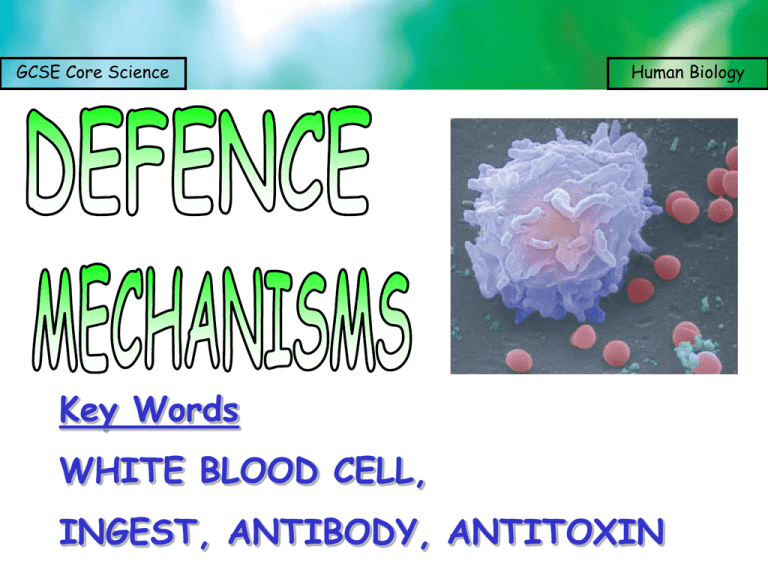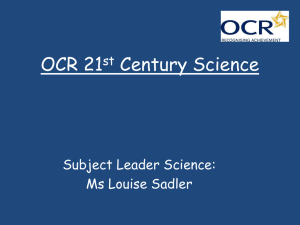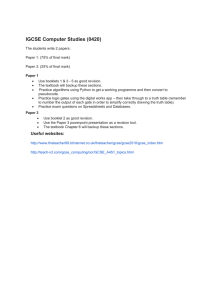white blood cells - science
advertisement

GCSE Core Science Human Biology Key Words WHITE BLOOD CELL, INGEST, ANTIBODY, ANTITOXIN GCSE Core Science Objectives By the end of the lesson I will: •Know a PATHOGEN is a microorganism that causes an infectious disease •Know pathogens reproduce before they make enough toxins to make you feel ill •Know that the best way to protect ourselves is through the first line of defence (the skin) and not let any pathogens into the body • Identify the second and third line of defence •Know what the white blood cells do to protect your body Human Biology GCSE Core Science Starter Human Biology There are four main ways in which you can get sick 1. Droplet infection – When a sick person coughs, sneezes or talks too close to you 2. Direct contact – through skin, kissing or other sexual contact 3. Contaminated food and/or drink – ingestion 4. Break in the skin – scratches or needle punctures I know HOW TO USE ASEPTIC TECHNIQUE GCSE Core Science How do we effect change? Human Biology We are going to grow some yeast….. AND THEN KILL IT! 1. Using ASEPTIC TECHNIQUE infect a petri dish with a yeast solution. 2. Wait for the solution to slightly dry (perhaps 1hour) 3. Place a full drop of antiseptic onto the centre of the agar plate. 4. Incubate for 24-48hours. WHAT ARE YOU TRYING TO FIND OUT? WHAT DO YOU EXPECT TO FIND OUT? GCSE Core Science How many lines of defence do you have in your body? Lines of defence Human Biology 1) Skin: Provides both a physical (protective layer that completely wraps around the body, shielding blood vessels, nerves, muscles, organs, and bones) and a chemical barrier (When there is a cut or tear in the surface of the skin pathogens can breach the bodies defence and so glands beneath the skin produce an enzyme that helps kill bacteria) GCSE Core Science Lines of defence Human Biology 2) Mucous membranes, stomach acid, cilia: • Mucous membranes, produce a sticky substance that traps irritants that enter through the nose. • Structures like tiny hairs, called cilia, line the body's airways and constantly wave foreign particles and mucus away from the lungs to where they can be swallowed safely. • Most harmful microbes that make it to the stomach are destroyed by stomach acids. • Tears and saliva both contain enzymes that destroy invaders. • The brain-blood barrier, a specialized "filter" that surrounds the brain and spinal cord and acts as a physical barrier to keep out proteins, toxins, and most microbes, while letting in glucose, the source of the brain's nutrients. GCSE Core Science Lines of defence Human Biology 3) Lymphatic system (white blood cells): You have white blood cells in your body that defend it by •Ingesting pathogens and destroying them (Never EVER say they eat the pathogen as this is WRONG. The only correct word is INGEST) •Some white blood cells produce antibodies that recognise the antigens that are on the surface of the pathogen. The anitbodies of the white blood cell then bind with the antigens of the pathogen which destroys the pathogen or tags it for ingesting by another white blood cell. Each antigen is different and so your body needs to produce an antibody to match each antigen. •Some white blood cells produce antitoxins to counteract the toxins produced by some bacteria. The toxins are bound and destroyed. GCSE Core Science Human Biology GCSE Core Science Lines of defence Human Biology GCSE Core Science Human Biology physical and chemical barriers most essential non-specific defences inflammation to attract white cells into tissues pathogen-specific most controllable defences ingestion of bacteria by white cells involves antibodies and T- and B-cells GCSE Core Science Delayed response Human Biology The B-lymphocyte that produces the correct antibody for the antigen begins dividing to produce many more antibodyproducing cells. It takes a few days to produce enough antibodies to destroy the pathogen. This means there is delay between infection and the person beginning to feel better. Once a pathogen has been destroyed, a few memory cells remain. These recognize the pathogen if it re-infects, and make the immune response much quicker and more effective. This is called active immunity. GCSE Core Science Research Human Biology Use pages 64-65 to complete the Provided worksheets on ‘White Blood Cells’ OR ‘Infection’ Miss will pair you with someone who you will work with. You will complete a different sheet each. You will then have to teach what you have learnt to your partner! GCSE Core Science Objectives By the end of the lesson I will: •Know a PATHOGEN is a microorganism that causes an infectious disease •Know pathogens reproduce before they make enough toxins to make you feel ill •Know that the best way to protect ourselves is through the first line of defence (the skin) and not let any pathogens into the body • Identify the second and third line of defence •Know what the white blood cells do to protect your body Human Biology






